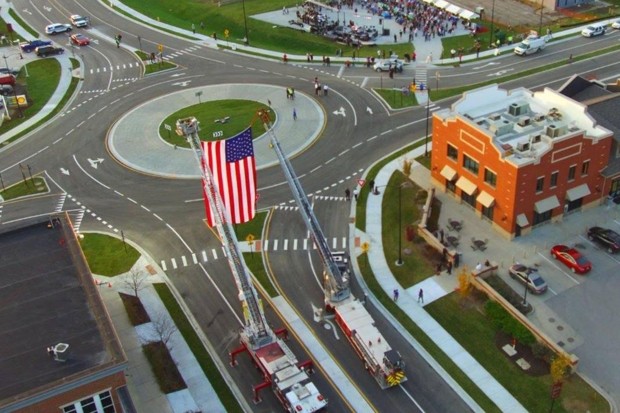Wish Nashville would consider more roundabouts such as at the intersection of Bowling Av and Woodlawn! The idea that a city's drivers could save gas and reduce air pollution while keeping traffic rolling is very appealing. As a pedestrian advocate, a roundabout has some pluses and some minuses. Drivers are really not prepared to stop BUT a walkers also does not have to wait, for what often seems like an eternity, to walk as long as they gauge the speed of oncoming traffic right. The initiative to change intersections into roundabouts change in Carmel, IN was mayor driven. If they could do it, Nashville could certainly do it.
Something to consider, Nashville!!!
All Hail Carmel, Indiana, America's King of Roundabouts
The city recently celebrated its 100th traffic circle, and has more than 30 others planned.
Folks who love that elegant traffic doughnut with a proven safety record—the roundabout—should consider relocating to Carmel, Indiana. The city recently debuted its 100th circular intersection, further solidifying its status as Exalted Roundabout Lord of the United States.
The intersection’s ribbon-cutting was marked with crowds, fireworks, live music, and a drone fly-over that captured the grass-centered ring in all its glory:
“This marks a milestone in a 20-year initiative to transform a transportation network that had previously been littered with failing, traditional suburban traffic lights, four-way stops, and other poorly functioning, dangerous intersections,” the city crowed in a press release. “The network-wide incorporation of modern roundabouts has transformed Carmel’s roadways into a smooth-flowing network that has dramatically reduced accidents.” (Indeed, the Federal Highway Administration says roundabouts decrease severe traffic accidents by about 80 percent compared to intersections with traffic lights or stop signs.)
Carmel and its roundabout-loving mayor, Jim Brainard, have helped push Indiana into the big league of U.S. states deploying roundabouts, despite its smaller size compared to, say, Colorado or California. In terms of individual U.S. cities, it appears to have no equal in this regard, though Colorado Springs comes a little close, with around 70 roundabouts. Plus, its one roundabout per 890 residents gives Carmel a “not too shabby” rating for roundabouts per capita, according to Bill Baranowski of the delightful website RoundaboutsUSA.
“Here in Utah, Riverdale City, with a population of 8,400, has 7 roundabouts so per capita there are one roundabout per 1,200 citizens,” emails Baranowski. “Avon, Colorado, 6,447/13=495 almost double your Carmel ratio.”
Carmel believes its horde of roundabouts, which don’t require drivers to stop and start, save the city’s motorists about 24,000 gallons of gas annually for each roundabout. And with more than 30 new roundabouts planned in the next few years, the city will continue to reap the environmental and safety benefits of this curvy, low-speed traffic intervention. So why aren’t more places in the U.S. coming around to roundabouts?
Ken Sides, a transportation engineer at Sam Schwartz, has a theory about why America continues to embrace the “ugly, unpleasant, and dangerous seas of asphalt” that are conventional intersections.
“Just as a strong local champion can get roundabouts built, as in the case of Mayor Brainard, a lack of strong national championship might be [a] reason,” Sides says. “[The Federal Highway Administration] does list modern roundabouts as a ‘proven safety countermeasure,’ but lumps roundabouts in with nine other countermeasures. [The Institute of Transportation Engineers] styles itself as an international leader in traffic engineering, but has issued only a tepid statement in support of modern roundabouts, in spite of the tens of thousands being constructed worldwide.”
If the U.S. were to get serious about roundabouts, it’d have to pick up the pace significantly. “At a national level, the United States would need at least 145,000 modern roundabouts to achieve roundabout parity with either France or Australia,” Sides says. “If the U.S. builds 7,050 roundabouts per year for the next 20 years, it would then be… 20 years behind France and Australia.”
Link:
http://www.citylab.com/weather/2016/11/all-hail-carmel-indiana-americas-king-of-roundabouts/508943/


No comments:
Post a Comment